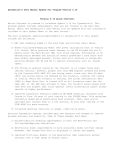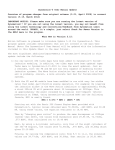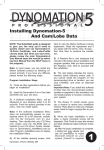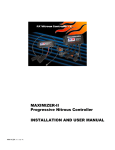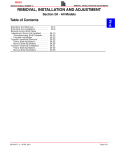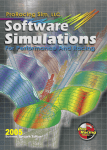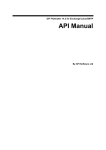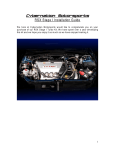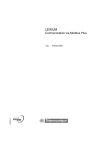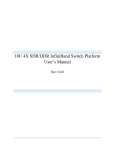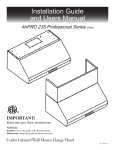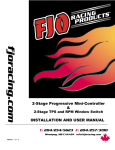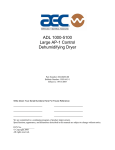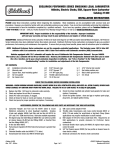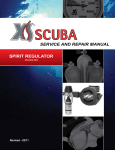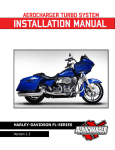Download Dynomation-5 User Manual Update For Program
Transcript
Dynomation-5 User Manual Update For Program Version 5.12 Version 5.12 Quick Overview: Motion Software is pleased to introduce Update 5.12 for Dynomation-5. This program update includes enhancements that are not covered in the main User Manual (Note: The Dynomation-5 User Manual soon will be updated with the information included in this Update Sheet). The most significant additions/improvements to Dynomation-5 include: A) Forcedinduction modeling improvements in both the Wave-Action and Filling-And-Emptying simulations, and B) The ability in the Wave-Action model to more accurately model Air/Fuel Charge movement. New Charge-Flow data is displayed in tables and graphs. This update also includes other new features and changes to improve program accuracy and usability. Some of these changes include: 1)Improved Frictional Models in the Wave-Action (WA) simulation extend accuracy over a wide range of engine sizes. 2) New Wave-Action (WA), Overlap-Flow modeling; helpful at high engine speeds with large duration cams. Improves WA simulation response to modifications in exhaust centerline (changed independently of intake centerline). 3)Improved Induction Air Temperature and Flow modeling for plenum and Individual Runner intake systems in both simulations. 4)Display of both Intake Manifold Pressure and Port Pressure (at minimum port area) in WA simulation. 5)WA and FE simulations re-calibrated to dyno-test and simulation baseline test data. Some engines may show a few percent lower power than previous versions of Dynomation-5 (particularly the FE sim), however, overall prediction accuracy should be improved. 6)Enhanced and more accurate reporting of MEP, HP, and other data in the tables of both simulations. 7)Improved Intake- and Exhaust-Modeling accuracy in FE simulation. 8) Corrected Hybrid-Sim display when used with RPM Steps of other than 500rpm. Using Dynomation-5.12 Charge-Flow-Analysis Features Dynomation-5 now includes the display of rpm-based, Charge-Mass flows within the engine. While similar to crank-angle flow data, the new rpm-based data reflects the “total” (end-of-valve-event) mass retained or discharged from each cylinder at the conclusion of exhaust and induction cycles. This accurately reflects the Fuel-Charge Mass in the cylinder at the beginning of compression and during power strokes. This data clearly shows how changes in cam timing, intake flow, and other engine parameters can affect the fuel retained and lost from each cylinder throughout the rpm range. This new data is displayed in both tables and graphs: • Trapped Mass: Total Charge Mass retained in each cylinder at the end of the intake cycle, measured at each rpm point in Pounds or Grams. • Lost Charge Mass (Displayed on Pro PrintOut only): Total Charge Mass that entered each cylinder but then escaped through reversion flow back into the intake tract and/or discharged with exhaust flow before the end of the exhaust and intake cycles, measured at each rpm point in Pounds or Grams. • Percentage Of Charge Lost To Reversion: Percentage of Total Charge Mass that entered each cylinder but then escaped in reversion flow back into the intake tract, measured at each rpm point. • Percentage Of Charge Lost To Exhaust Flow: Percentage of Total Charge Mass that entered each cylinder but then escaped with exhaust flow, measured at each rpm point. • Percentage Of Charge Spoiled By Exhaust Gasses: Percentage of Total Charge Mass “spoiled” by exhaust gasses that moved into the cylinder (rather than out) during the exhaust valve event, measured at each rpm point. • BSFC (Brake Specific Fuel Consumption): A standard measure of the fuel used by the engine during a specific time period to produce a known (brake) power level, measured at each rpm point in Pounds-per-Horsepower-Hour or Grams-per-Kilowatt-Hour. • Fuel Flow Rate: A standard measure of fuel consumption during a specific time period, measured throughout the rpm range in Pounds-per-Hour or Grams-per-Hour. • Fuel Conversion Efficiency (Shown only in ProTools Table; not displayed on Pro PrintOut): A standard percentage measure of the efficiency at which fuel energy is converted into usable power output, measured at each rpm point. These mass flow measurements are calculated during every Wave-Action simulation and are displayed in the tables (Standard and ProTools Tables). These new measurements also can be plotted on the top-right (rpm-based) graph by rightclicking the graph and assigning the Y1 (normally Power) and/or Y2 (normally Torque) to any Charge-Mass variable. Particularly powerful and easy to interpret are the Percentage Flow values (Lost to Reversion, Lost to Exhaust, and Spoilage Flow). Percentage charge flows clearly show where charge flow inefficiencies occur in any engine design. For example, if you are simulating an engine primarily for optimum power, an overall design that limits reversion flow will maintain higher charge density in the cylinder. If charge is allowed to “revert” into the intake track, it will not be available to produce power during the following combustion and power stroke events. Reversion flow into the intake typically occurs at the end of the intake valve event, when the piston is moving up the bore and the intake valve is still open. This phenomenon often shows-up at lower speeds, when the induction system may not generate sufficient charge-flow energy to keep air and fuel moving in the “right” direction; into the cylinder. In these cases, piston motion forces inducted charge to change direction and move back into the intake tract. The result is lower volumetric efficiency and a reduction in power output. However, reverted charge is not necessarily “lost energy,” since it is still present in the induction tract and is available during the next induction cycle to potentially contribute to trapped mass and power output. Reversion can also be triggered by Exhaust Spoilage flow. At the beginning of valve overlap, when the intake valve is just opening and the exhaust valve is closing, if sufficient pressure exists in the exhaust system or if the intake valve is opened too soon, exhaust gasses can reverse flow and move into the induction system. This is a particularly potent power killer. Not only is charge reverted, but it’s partially “spoiled” by exhaust gasses. So, after overlap, during the remaining portion of the intake cycle, this spoiled charge is drawn back into the cylinder and lowers power output (similar to EGR power loss). On the other hand, if induction-flow momentum is sufficient to drive unburned fuel through the combustion space and into the exhaust tract (during valve overlap), it is truly lost with exhaust flow as an energy source. This increases fuel consumption, but it has benefits in high-performance applications. Charge Flow To Exhaust helps drive out residual exhaust gasses and optimizes trapped mass to produce peak power. Once again, it is obvious how tuning for power and economy can be at different ends of the engine-design spectrum. All of these phenomena are easily seen and analyzed by reviewing Percentage Charge Mass data in the last three columns of the ProTools table. As you look down the columns, through the rpm-test range, reversion flow often comes-andgoes as the engine moves into and out of tune. Exhaust Spoilage flow may occur at high engine speeds with large-displacement engines as exhaust-system pressure increases. Charge Lost To Exhaust flow can also come-and-go as the induction system moves through its tuning peaks. This complex interplay of mass flows can be readily visualized just by reviewing the data in these columns. Using Dynomation-5.12 Fuel-Flow Data In addition to Charge Mass analysis, Fuel-Flow data is also calculated in Dynomation-5 and is displayed in tables and can be shown on the rpm graph. Fuel consumption data (BSFC, Fuel Flow Rate, and Fuel Conversion Efficiency) indicates the efficiency of fuel-energy conversion into usable mechanical work. One of the most commonly measured and quoted fuel-efficiency parameters is Brake Specific Fuel Consumption (BSFC). BSFC has units of Pounds per Horsepower-Hour (also Grams per Kilowatt-Hour). This variable indicates the amount of fuel required to produce specific engine output over a measured duration of time. Typical values for spark-ignition engines operating at optimum efficiency run around 0.40 to 0.45, with lower numbers indicating higher efficiency. BSFC values are widely used because they are applicable across a wide range of engines, from 50cc 2-stroke engines, to large Diesels, and even turbine engines! BSFC for each of these engines is directly comparable, giving a clear measure of the overall fuel efficiency within a diverse range of powerplants. BSFC for IC engines simulated in Dynomation-5 are highest when the engine is run at wide-openthrottle (as is typically the case in Dynomation-5) and engine speed is near the torque peak. BSFC will increase (efficiency decreases) in other operating ranges. Another useful fuel consumption measurement calculated by Dynomation-5 is Fuel Flow Rate (in Pounds per Hour or Grams per Hour). This parameter simply indicates the gross fuel flow consumed by the engine. Since fuel pumps are commonly rated in Pounds-per-Hour for maximum fuel delivery, a direct comparison Fuel Flow Rates is an easy way to confirm that pump capacity is sufficient for any particular engine application. Each type of fuel has a unique energy content and heat-release potential per unit mass. This is measured in a standardized test where a specific amount of fuel is burned and the heat release is measured by a calorimeter as combustion products cool to ambient temperature. Since this heat-release content can be directly compared with work produced by the engine, it can be used to determine the Fuel Conversion Efficiency of the engine, sometimes referred to as the Thermal Efficiency. This is the “third” in the efficiency measurements, along with Volumetric Efficiency and Mechanical Efficiency (already calculated and displayed by Dynomation-5 in pre-5.12 versions). Fuel Conversion Efficiency will range around 30% for most automotive engines. Using Forced-Induction Modeling In Dynomation 5.12 A number of improvements to forced-induction modeling have been included in version 5.12. IMPORTANT: Because of changes in Dynomation 5.12.0924, it is essential that you RESELECT any forced-induction compressor (turbo, roots, screw, centrifugal) when you OPEN an engine file saved from a PREVIOUS verison of Dynomation-5! Also you should RESELECT the exhaust-system in the FE simualtion to ensure that the simulation is using the correct exhaust model (as indicated in the FE Exhaust-System menu, only use Large or Small Open Headers when you are modeling an engine with a forced induction system; other exhaust-system choices may produce unreliable resutls). Remember to SAVE the file to “lock in” any reselected values. Here is a list of the most important changes/fixes in version 5.12 that affect forced-induction modeling: 1)Wave Action simulation now returns more accurate forced-induction results due to the transfer of normally-aspirated VE values to the supercharger routines; some issues previously existed when the engine step value for the WA sim was not 500rpm. Note: Naturally-aspirated VE values are used in the determination of baseline engine-flow capabilities upon which are built forced-induction flow characteristics. It is for this reason, both the WA and FE run TWICE when forced-induction systems are modeled; the first simulation pass generates naturally-aspirated VE values). 2) Turbocharger backpressure modeling is more robust. In earlier program versions, excessively high power values sometimes would be generated in high-boost applications, particularly in the WA simulation. These erroneous power values have been eliminated through more accurate exhaust backpressure modeling and how these pressure effects change overall engine flow. 3) The forced-induction modeling routines (like their naturally-aspirated counterparts) draw induction airflow through the “orifice of rated flow” for the entire engine. This field is labeled Total Induction Airflow Rate and is found near the top of the INDUCTION Category. For example: If you specify 600cfm as the total airflow rate (for, say, a carburetor or throttle body), and subsequently add a supercharger to the engine with 14psi of boost at the waste gate, the additional induction airflow mass...about twice the naturally-aspirated flow...will be drawn through the same induction orifice, generating a higher pressure drop. If you do not set the Total Induction Airflow Rate to the appropriate values in a supercharged applications, excessive intake restriction will lower boost values, increase the engine speeds at which peak boost occurs (slower spool-up with turbos), and even prevent the supercharger from reaching its waste gate (peak boost) pressure anywhere in the rpm range. 4) If you install a turbocharger on an engine, the simulation will NOT automatically set the correct TURBINE size for the selected COMPRESSOR. Once you have selected a “turbo” from the menu (a selection of the COMPRESSOR), make sure that you choose an appropriate TURBINE (exhaustdriven element). Use the Turbine Size menu to match the turbine wheel to the compressor. Smaller turbines will spin up faster and may not deliver the same maximum pressure as larger turbines that spin up slower. The A/R ratio of the Turbine housing is another important selection in the Forced Induction category. This is a ratio of the cross-sectional area of the turbine housing inlet to the radius. Typically, a larger Turbine A/R produces less boost at lower engine speeds but develops higher boost at higher engine speeds, Refer to the User Manual for more information in selecting turbochargers and supercharger components. 5) You may now display the blower map used by the supercharger modeling routines for Turbochargers and Centrifugal Compressors. Activate this function by opening the Simulation drop-down menu (just above the ToolBar at the top of the program screen) and choosing Show Compressor Map. The next time the simulation is run (with a Turbocharger or Centrifugal compressor installed on the engine), the compressor map will open in a window over the simulation. The simulation will draw the engine demandline (in black) over the map display. Ideally, the engine demand should pass through the center of the map island. This indicates the compressor is operating near optimum efficiency. With this Map display, you can quickly diagnose Choke, Overspeed, and Flow issues. Refer to the main User Manual for more information on blower matching and selecting the right supercharger for your application. Note: The map only displays when Turbochargers and Centrifugal Compressors are used. Internal, non-displayable, map data is used for Roots and Screw blowers. Dynomation Practical Usage Tips • The new Charge-Flow data variables (used by the WA simulation) in version 5.12 are quite sensitive to IVO, EVC and the amount of valve overlap (when both the intake and exhaust valves are open). Slight changes in IVO, EVC, and overlap duration often can have dramatic effects on charge reversion or fuel lost to exhaust flow. While searching for optimum chargeflow characteristics, try changing individual valve events (IVO, EVC) to optimize flow characteristics while keeping an eye on power output to find the “sweet spot” in engine efficiency for your combination. • Some Dynomation users have been unsure how to use the SIMPLE induction models provided in the Induction drop-down menu. There are two SIMPLE induction models: One for Plenum induction systems and another for IR (Individual Runner) engine configurations. Here’s the bottom line on Induction choices: The SIMPLE model is the best option when you begin your engine-development efforts. The SIMPLE models use data directly from the simulation (particularly the Wave-Action simulation) without modification. Other (non-SIMPLE) induction models “impose” manifold characteristics upon simulation results to help you evaluate how an engine might perform with various induction systems. Keep in mind that manifold choices do not lengthen, shorten, or change any of the (Wave-Action) Intake-Runner characteristics specified in the INDUCTION Component Category. If you begin your engine design with a SIMPLE induction choice, you will be working directly with “raw” simulation results. When your engine design has progressed, try other manifold choices to see how they are likely to affect engine performance. • Dynomation-5 lets you to use one set of intake and exhaust valve sizes during flow-bench testing (“test” valve diameters are entered in the Port Flow Dialog box along with port flow and lift data), while using different valve sizes in the simulated engine (entered in the CYLINDER HEAD Component Category). This feature can add versatility to your flow bench data; since you may wish to explore what power differences are possible with different (usually larger) valves in the engine without having to obtain new flowbench data. This is a handy feature, but there’s a gotcha! If you use valves sizes that are significantly different from those used during flow-bench testing, engine simulation accuracy will suffer. If the differences are only 0.010- or 0.020-inch on a 2.000-inch valve, accuracy will be good. On the other hand, if the valves in the engine are substantially different from flow-bench data, say 0.100-inch on a 2.000inch valve, prediction accuracy will be reduced. If you wish to maintain the highest simulation accuracy, use the same size intake and exhaust valves in the simulated engine that were used during flow-bench testing. • If you getting “strange” results when you load an engine file created by a previous program version, before anything else, RESELECT each component in all categories to ensure that the simulation is using the desired values in every component field. NOTE: Component reselection is NEVER REQUIRED when you load or create an engine file that you built from “scratch” using the CURRENT VERSION of the program (in this case, version 5.12.0924). • Incorrect simulations results also may be due to an incorrect data entry that you just “can’t see,” no matter how many times you scan over the Component screen. Do a ProPrint printout to help you review your engine data. And don’t forget to give port-airflow data a close look. Make sure the pressure drops entered in the Port-Flow dialog box are correct. • If you are having difficulties building an engine in the latest version of Dynomation-5 or the simulation results are not what you expect, please contact our support team. We want to help you get the most from Dynomation! Covers the following Dynomation versions: Dynomation5.09 (charge flow changes) Dynomation5.10 (charge flow, additional minor updates & fixes) Dynomation5.12 (airflow restriction modifications for forced induction) Dynomation5.12 (supercharger fixes, overlap, charge-flow refinements) September 24, 2010







